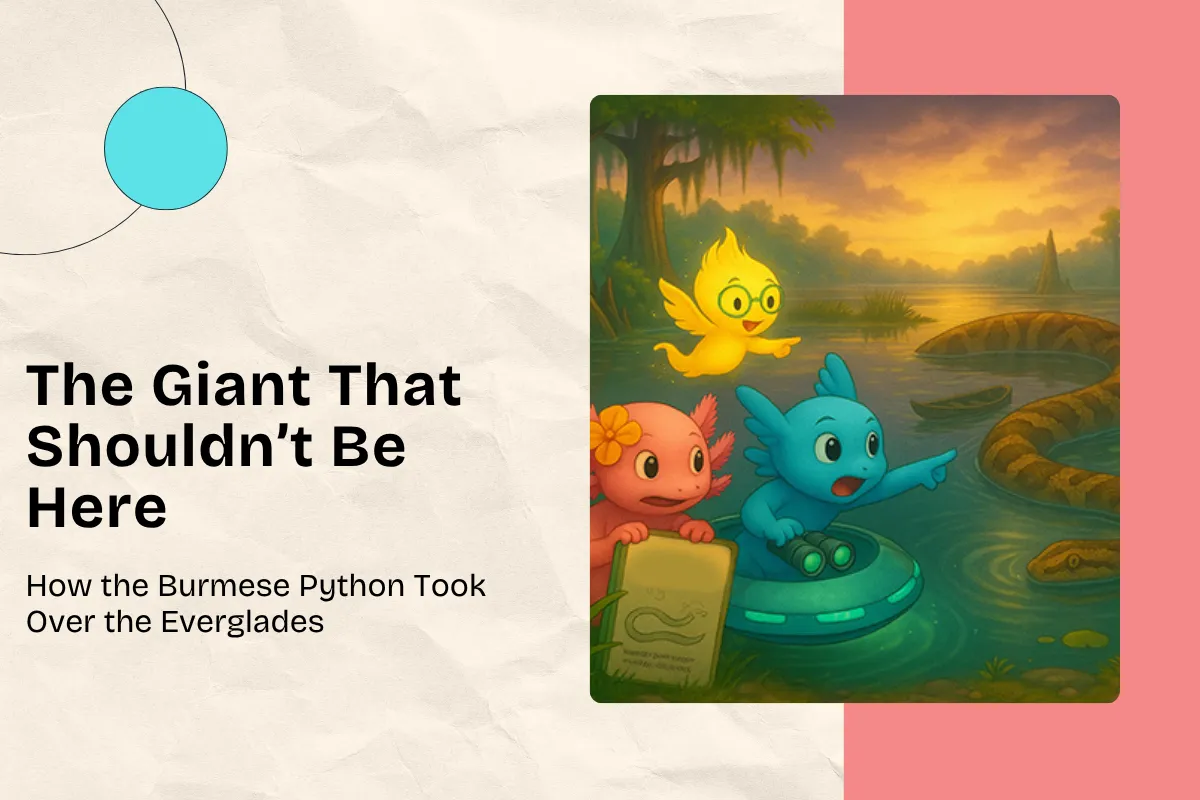
The Giant That Shouldn’t Be Here
🐍 The Giant That Shouldn’t Be Here: How the Burmese Python Took Over the Everglades
Lotty & Finn Science Spotlight Series – Part 2 of 4
The Forever Glades are full of surprises — shimmering wetlands, whispering reeds, and creatures of every size and shape. But one new arrival has stretched “big” to a whole new level.
Meet the Burmese python, a reptile so massive that even Glowria’s glow dims a little when she talks about it.
Glowria says: “When a snake grows longer than a canoe and eats like a crocodile, nature takes notice.”
🪶 A Visitor from Far, Far Away
The Burmese python didn’t slither to Florida on its own. It’s native to Southeast Asia, where it lives in forests and wetlands much like the Everglades — hot, humid, and filled with prey.
Starting in the 1970s, people around the world began buying them as exotic pets. Tiny, patterned, and docile at first — but soon, that cute hatchling grew into a 12-foot powerhouse.
Finn: “Imagine outgrowing your tank so much that you need your own swimming pool!”
Lotty: “And that’s when some people decided these snakes were just too much to handle.”
Many were released into the wild by owners who didn’t realize the ecological consequences.
Then, in 1992, Hurricane Andrew — a Category 5 storm — struck southern Florida and destroyed a breeding facility. Dozens of snakes escaped into the surrounding wetlands.
Together, these accidental releases became the foundation for a growing wild python population.
Glowria: “And once nature rolls the dice, the numbers start multiplying fast.”
🌴 Why the Everglades Were the Perfect Python Paradise
Florida’s Everglades National Park is a wonder of its own — one of the largest wetlands in the world and home to hundreds of unique species. Unfortunately, it also turned out to be the perfect home for pythons.
Here’s why they settled in so easily:
Ideal habitat: Warm weather, shallow water, and endless hiding spots.
Plenty of food: Raccoons, rabbits, birds, even alligators.
No predators: Nothing big enough to hunt a full-grown python.
Fast reproduction: Females can lay 50–100 eggs at a time.
With all these advantages, the python population exploded. Scientists estimate tens of thousands, maybe over 100,000, now live in the Everglades.
Lotty: “No wonder the locals call them ‘the silent takeover.’”
Finn: “And they don’t even hiss?”
Glowria: “Oh, they hiss — but nature’s warning signs were even louder.”
💡 Science Spotlight: How the Burmese Python Became an Invasive Species
Timeline of the Takeover:
1970s–80s: Burmese pythons imported as exotic pets.
1992: Hurricane Andrew releases many into the wild.
Early 2000s: First confirmed breeding populations discovered.
2010s–today: Widespread across South Florida; sightings moving north.
Key facts:
Native to Southeast Asia, not North America.
Opportunistic feeders: they eat mammals, birds, reptiles — anything that fits.
Extremely difficult to locate or trap due to camouflage and stealth.
No natural predators once they reach adulthood.
Glowria explains: “It’s a case study in what happens when nature’s checks and balances are removed. Think of it as a system with no ‘off’ button.”

🐇 The Vanishing Wildlife
Once pythons became established, scientists noticed major changes in wildlife populations. Studies show:
Raccoons and opossums: Declined by more than 90% in some areas.
Rabbits and foxes: Nearly disappeared.
Wading birds: Fewer nests in python-heavy zones.
Small alligators and deer: Found inside python stomachs (yes, really!).
The Everglades’ food web began to unravel. Animals that once helped control insects, disperse seeds, and feed predators vanished almost overnight.
Finn: “It’s like removing half the players from a soccer game — the rest can’t win.”
Lotty: “And the referee’s on vacation.”
Glowria: “Exactly. When one species grows out of control, everyone else plays catch-up.”
🔍 Why They’re So Hard to Stop
Catching pythons isn’t easy. They blend into the reeds like camouflage champions and can stay underwater for long periods.
Wildlife officials have tried everything:
Trained detection dogs to sniff them out.
Radio-tagged “scout snakes” to find others during mating season.
Public hunts like the Florida Python Challenge to encourage safe removal.
Strict bans on importing or owning them as pets.
Despite removing thousands every year, the population keeps growing. Scientists say eradication is nearly impossible — but control and awareness are making a difference.
Glowria: “You can’t turn back time, but you can learn from the clock.”
🌍 Lessons from the Forever Glades
The Burmese python invasion teaches an important lesson: one decision can echo through an entire ecosystem.
When people bring species into new environments — even with good intentions — it can upset the delicate balance that nature took centuries to build.
Lotty: “It reminds me of our lakes back home. Invasive fish caused big trouble for axolotls too.”
Finn: “So, are humans an invasive species sometimes?”
Glowria: [smiling] “Only when they forget they’re part of nature, not apart from it.”
The Everglades may never return to what they once were, but the people working to restore them are proof that curiosity and care can still make a difference.
🪶 Want to Learn More?
Check out Part 1: Invaders in the Glades to discover what makes a species “invasive.”
Next up in the series: Part 3 – Predators with No Predators, where we’ll explore how pythons affect the food chain and why balance in nature matters to everyone — even us axolotls.
📚 Explore & Create
Inspired by this story? Dive into our creative world with Year of the Snake — a guided book that helps readers turn science into storytelling.
And don’t forget to follow or subscribe for the next Science Spotlight adventure — perfect for #homeschool and #scienceforkids explorers everywhere!

PS: Lotty & Finn live in our imagination, where adventures are full of curiosity and fun! If you’re caring for real axolotls, always check with experts for proper guidance. Curious to dive deeper? Visit ourExplorer Resources pagefor trusted sources and links. 🌊
